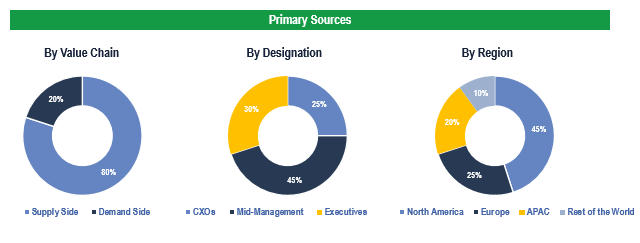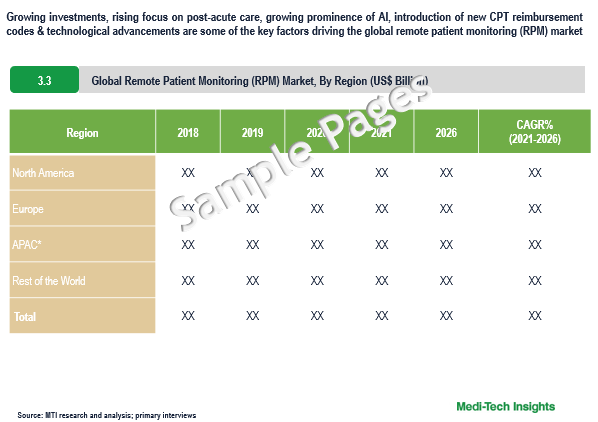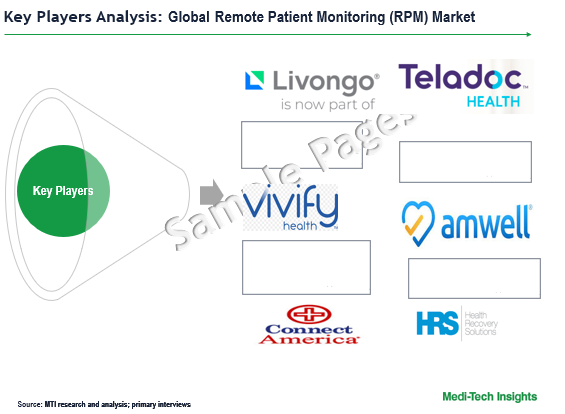
Remote Patient Monitoring Market Size, Share & Growth Opportunities by 2026
The US remote patient monitoring market holds a major share in the global remote patient monitoring market. The US RPM market alone is expected to be over $18 billion opportunity by 2026. It is set to witness a healthy CAGR of 25% (2021-2026) driven by the increasing prevalence of chronic diseases, the introduction of new CPT reimbursement codes by the CMS, the Covid-19 pandemic-driven surge to move hospital care into the home, and technological advancement in RPM hardware, software and patient care capabilities.
Medi-Tech Insight’s latest analysis reveals a huge and an untapped growth opportunity in the global remote patient monitoring market. The remote patient monitoring market report deep dives into key growth levers, pricing intelligence, competitive landscape, segment analysis, product/offering mapping & untapped growth pockets.
Healthcare is a field which is rapidly developing and is marked by incessant advancements in technology and services. A significant development in this field is remote monitoring of patients which offers several advantages in a fast-aging world population with growing health complications. The technology has developed to the extent that patients can be monitored not only inside hospital rooms but also at home with the use of modern communication and sensor technologies. Technological advancements in remote patient monitoring devices allow the monitoring of multiple vital sign parameters such as blood pressure, heart rate, respiration rate, electrocardiogram reading, temperature, and blood glucose levels, among others. The technology is being used to monitor a diverse group of individuals such as chronically ill patients, accident victims, elders, and premature children.
Key Influencing Factors: Global Remote Patient Monitoring Market
Growth Drivers: RPM Market
- Introduction of CMS-approved expanded code set for Remote Therapeutic Monitoring/Treatment Management (RTM) in 2022. The 2022 CPT reimbursement codes for RTM - 98975, 98976, 98977, 98980, +98981 allow reimbursement to providers for collecting and interpreting non-physiological data of respiratory system status, musculoskeletal system status, therapy adherence, and therapy response
- Introduction of CPT reimbursement codes by the CMS in 2019 (CPT 99453, CPT 99454, CPT 99457) and 2020 (CPT 99458) to broaden the adoption of RPM services.
- Rising burden of chronic diseases and pressure to reduce healthcare costs.
- Growing recognition of RPM as a tool to proactively monitor and improve patient engagement, and reduce ED visits, readmissions, and lengths of stay in hospital—all of which help improve patient outcomes and contain costs.
- Presence of 200+ small and mid-size companies in RPM space leading to a competitive environment for growth and innovation.
- Favourable investment landscape for RPM & Telehealth.
Market Barriers/Challenges: RPM Market
- Continuous Data Monitoring - Cumbersome to monitor all the data 24*7 by the physicians/clinical staff & frequent false alerts.
- Patient Readiness & Data Privacy Concerns - Most chronically ill individuals are older, generally less tech-savvy, and often warier that technology will intrude on their personal life.
- Data Integration – Integrating third-party RPM data with the EHR.
Covid-19 Lends a Positive Spin to the Remote Patient Monitoring Market Growth
Covid-19 pandemic had a positive impact on the remote patient monitoring market as the value of RPM services became even more apparent. The next phase of growth is expected to be driven by increased adoption and usage of remote patient monitoring services in the ongoing pandemic, and the need to reduce patient costs and improve outcomes for patients with chronic conditions. Patient demand and financial incentives for providers and health systems are driving demand for post-acute care in areas like cardiology, orthopedics amongst others.
Providers are the Biggest Users but Other High Growth Segments Are Also Emerging
While the largest segment continues to be providers, other segments like health plans/payors, employers, home health agencies, and clinical trials are expected to grow substantially over the next 5 years.
Global Remote Patient Monitoring Market – A Highly Fragmented Market
The global RPM market is highly fragmented with over 200 companies vying to grab a share of this nascent market and it is critical for RPM companies to deploy well-researched pricing and go-to-market strategies. Companies from the Telehealth market and PERS market are also eyeing entry into the remote patient monitoring market as seen by the acquisition of Livongo by Teladoc recently.
Key Growth Levers for Remote Patient Monitoring Market Companies Include:
- Offering solutions that are comprehensive, integrated, and tailored to chronic disease areas like diabetes, COPD, hypertension.
- Incorporation of AI/ML into RPM solutions to increase patient engagement & compliance.
- Going beyond capturing data and helping physicians to manage patient populations to improve outcomes and reduce costs.
- Partnerships with third parties including technology companies, device manufacturers, and patient care companies to offer a holistic care pathway.
- Strategic M&A to acquire wider coverage of geographies, disease areas and to gain scale and financial muscle.
Business Models and Competitive Landscape Analysis of Remote Patient Monitoring Market
Currently, multiple business models are being deployed but Subscription Based Model is the most widely used business model in the remote patient monitoring market. Under this model, remote patient monitoring companies provide providers access to RPM devices and platforms which in turn are shared with patients for remote monitoring of their vital signs and other physiological parameters.
In terms of the competitive landscape analysis, the global remote patient monitoring market is marked by the presence of both established players and several small players. Some of the key players operating in the global remote patient monitoring market are Vivify Health, Health Recovery Solutions, Teladoc-Livongo, Amwell, AMC Health, Careclix, Ontrak, Accuhealth, iHealth Labs and many others.
Innovative companies are differentiating from their competitors by fine-tuning their business models, refining their product & service offerings, and tailoring pricing strategies based on the type of customer segment, geographic coverage, population health metrics & continuum of care offered.
Future Outlook of Remote Patient Monitoring Market
The future prospects of the global remote patient monitoring market looks promising. The RPM market is expected to gain further momentum in the upcoming years due to growing investments in RPM & Telehealth, rising focus on post-acute care, advantages of RPM such as the reduced risk of disease transmission, faster access to patient data, improved patient outcomes, freeing up of limited resources to address most serious cases & cost savings, entry of new players in the RPM market, technological advancements, growing prominence of artificial intelligence (AI) in remote patient monitoring and rising geriatric population.
Today, there is a unique window of opportunity to tap into this high-growth remote patient monitoring market by developing the right strategies and leveraging industry acumens.
Key Strategic Questions Addressed
- What is the market size & forecast of the remote patient monitoring market?
- What are the historical, present, and forecasted market shares and growth rates of various segments and sub-segments of the remote patient monitoring market?
- What are the key trends defining the remote patient monitoring market?
- What are the major factors impacting the RPM market?
- What are the opportunities prevailing in the remote patient monitoring market?
- Which region has the highest share in the global RPM market? Which region is expected to witness the highest growth rate in the next 5 years?
- Who are the major players operating in the remote patient monitoring market?
- What are the key strategies adopted by players operating in remote patient monitoring market?
The study has been compiled based on the extensive primary and secondary research.
Secondary Research (Indicative List)

Primary Research
To validate research findings (market size & forecasts, market segmentation, market dynamics, competitive landscape, key industry trends, etc.), extensive primary interviews were conducted with both supply and demand side stakeholders.
Supply Side Stakeholders:
- Senior Management Level: CEOs, Presidents, Vice-Presidents, Directors, Chief Technology Officers, Chief Commercial Officers
- Mid-Management Level: Product Managers, Sales Managers, Brand Managers, R&D Managers, Business Development Managers, Consultants
Demand Side Stakeholders:
- Stakeholders in Providers, Payors, Home Health & Hospice Agencies, among others.
Breakdown of Primary Interviews

Market Size Estimation
The market size was derived based on extensive secondary research further validated through expert interviews.
Data Triangulation
Research findings derived through secondary sources & internal analysis were validated with primary interviews and an internal knowledge repository.



